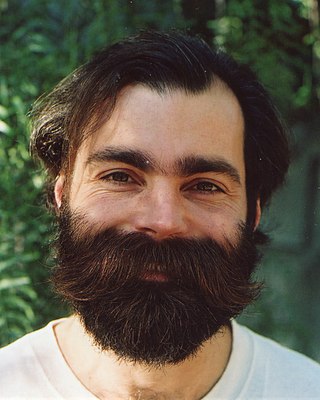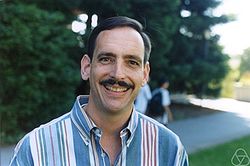In mathematics, specifically set theory, the continuum hypothesis is a hypothesis about the possible sizes of infinite sets. It states that
there is no set whose cardinality is strictly between that of the integers and the real numbers,
Mathematical logic is the study of formal logic within mathematics. Major subareas include model theory, proof theory, set theory, and recursion theory. Research in mathematical logic commonly addresses the mathematical properties of formal systems of logic such as their expressive or deductive power. However, it can also include uses of logic to characterize correct mathematical reasoning or to establish foundations of mathematics.
Paul Joseph Cohen was an American mathematician. He is best known for his proofs that the continuum hypothesis and the axiom of choice are independent from Zermelo–Fraenkel set theory, for which he was awarded a Fields Medal.

Set theory is the branch of mathematical logic that studies sets, which can be informally described as collections of objects. Although objects of any kind can be collected into a set, set theory — as a branch of mathematics — is mostly concerned with those that are relevant to mathematics as a whole.
In set theory, Zermelo–Fraenkel set theory, named after mathematicians Ernst Zermelo and Abraham Fraenkel, is an axiomatic system that was proposed in the early twentieth century in order to formulate a theory of sets free of paradoxes such as Russell's paradox. Today, Zermelo–Fraenkel set theory, with the historically controversial axiom of choice (AC) included, is the standard form of axiomatic set theory and as such is the most common foundation of mathematics. Zermelo–Fraenkel set theory with the axiom of choice included is abbreviated ZFC, where C stands for "choice", and ZF refers to the axioms of Zermelo–Fraenkel set theory with the axiom of choice excluded.
In the mathematical discipline of set theory, 0# is the set of true formulae about indiscernibles and order-indiscernibles in the Gödel constructible universe. It is often encoded as a subset of the natural numbers, or as a subset of the hereditarily finite sets, or as a real number. Its existence is unprovable in ZFC, the standard form of axiomatic set theory, but follows from a suitable large cardinal axiom. It was first introduced as a set of formulae in Silver's 1966 thesis, later published as Silver (1971), where it was denoted by Σ, and rediscovered by Solovay, who considered it as a subset of the natural numbers and introduced the notation O#.
In the mathematical field of set theory, a large cardinal property is a certain kind of property of transfinite cardinal numbers. Cardinals with such properties are, as the name suggests, generally very "large". The proposition that such cardinals exist cannot be proved in the most common axiomatization of set theory, namely ZFC, and such propositions can be viewed as ways of measuring how "much", beyond ZFC, one needs to assume to be able to prove certain desired results. In other words, they can be seen, in Dana Scott's phrase, as quantifying the fact "that if you want more you have to assume more".
The axiom of constructibility is a possible axiom for set theory in mathematics that asserts that every set is constructible. The axiom is usually written as V = L. The axiom, first investigated by Kurt Gödel, is inconsistent with the proposition that zero sharp exists and stronger large cardinal axioms. Generalizations of this axiom are explored in inner model theory.
In mathematics, the axiom of determinacy is a possible axiom for set theory introduced by Jan Mycielski and Hugo Steinhaus in 1962. It refers to certain two-person topological games of length ω. AD states that every game of a certain type is determined; that is, one of the two players has a winning strategy.
In set theory, L(R) (pronounced L of R) is the smallest transitive inner model of ZF containing all the ordinals and all the reals.

John Robert Steel is an American set theorist at University of California, Berkeley. He has made many contributions to the theory of inner models and determinacy. With Donald A. Martin, he proved projective determinacy, assuming the existence of sufficient large cardinals. He earned his Ph.D. in Logic & the Methodology of Science at Berkeley in 1977 under the joint supervision of John West Addison Jr. and Stephen G. Simpson.
Determinacy is a subfield of set theory, a branch of mathematics, that examines the conditions under which one or the other player of a game has a winning strategy, and the consequences of the existence of such strategies. Alternatively and similarly, "determinacy" is the property of a game whereby such a strategy exists. Determinacy was introduced by Gale and Stewart in 1950, under the name "determinateness".
In set theory, the core model is a definable inner model of the universe of all sets. Even though set theorists refer to "the core model", it is not a uniquely identified mathematical object. Rather, it is a class of inner models that under the right set-theoretic assumptions have very special properties, most notably covering properties. Intuitively, the core model is "the largest canonical inner model there is" and is typically associated with a large cardinal notion. If Φ is a large cardinal notion, then the phrase "core model below Φ" refers to the definable inner model that exhibits the special properties under the assumption that there does not exist a cardinal satisfying Φ. The core model program seeks to analyze large cardinal axioms by determining the core models below them.
In set theory, Ω-logic is an infinitary logic and deductive system proposed by W. Hugh Woodin as part of an attempt to generalize the theory of determinacy of pointclasses to cover the structure . Just as the axiom of projective determinacy yields a canonical theory of , he sought to find axioms that would give a canonical theory for the larger structure. The theory he developed involves a controversial argument that the continuum hypothesis is false.

Peter Koellner is Professor of Philosophy at Harvard University. He received his Ph.D from MIT in 2003. His main areas of research are mathematical logic, specifically set theory, and philosophy of mathematics, philosophy of physics, analytic philosophy, and philosophy of language.
This is a glossary of set theory.
The Gödel Lecture is an honor in mathematical logic given by the Association for Symbolic Logic, associated with an annual lecture at the association's general meeting. The award is named after Kurt Gödel and has been given annually since 1990.



